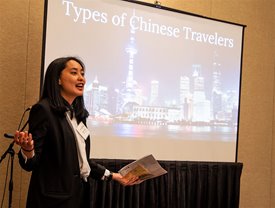Pittsburgh Preps for Nonstop Charter from China
From airport greeters to hoteliers and tour groups, we’re going to school on Chinese culture, customs
By Kristin Mageras
Published August 1, 2018
Read Time: 3 mins
If you’re in Pittsburgh, look at your watch. (OK, your phone.) What time is it? Now add 12 hours. That’s what time it is in China. Exactly half a world away.
Culturally, America and China might be worlds apart – literally day and night. But that’s about to change. This Friday and again on Aug. 11, two direct flights from Shanghai will bring hundreds of Chinese tourists to the City of Three Rivers. The airport, and a group of Pittsburgh partners, is working hard to roll out the welcome mat.
“We don’t get a second chance to make a first impression,” said Craig Davis, CEO of VisitPITTSBURGH. “The Chinese tourists will be using Weibo and WeChat (their versions of Facebook and Twitter) right away telling relatives, friends and colleagues if this is the trip of a lifetime or a bust, and much of that depends on how they are received culturally.”
The goal of these charters is to accelerate scheduled commercial service direct from Shanghai and other cities. The charter-to-scheduled service model has been successfully adopted in other parts of the world, and Pittsburgh is the first U.S. market to tap into China’s fast-growing tourism market with this type of business model.
Through a grant from the R. K. Mellon Foundation, hundreds of travel and tourism representatives, as well as staff from Pittsburgh International Airport, have been trained by VisitPITTSBURGH, Guest Services Solutions and Idea Foundry to help them better understand and serve the Chinese market.
The three organizations held 11 training sessions earlier this year for employees at Pittsburgh hotels, restaurants, tours and attractions. Each organization used a “train-the-trainer” model so attendees could take what they learned back to their respective organizations.
Part of the training focused on Chinese cultural idiosyncrasies. For instance, the color white in Chinese culture means death; better to use red or gold instead. Don’t book Chinese guests on the 4 th floor of a hotel, as that number means bad luck. There’s also a misconception that Chinese people are rude.
“Differences in mannerisms are the culprit here,” says Yiqun Sun, program manager for Idea Foundry, a nonprofit economic development organization with a global initiatives focus on China. “Chinese people are typically more reserved and avoiding eye contact is seen as respectful. Because of high concentrations of people in China, they are more likely to form crowds than lines, which appears pushy in Western cultures.”
Employees, volunteer ambassadors and concessionaires at PIT are being trained as well.
“For many, the airport is the beginning and end of brand for Pittsburgh,” said Elise Farris, PIT’s customer service manager. “We have to be ready.”
This week, airport staff are putting the final welcoming touches on the terminal to make Chinese visitors feel welcome: A final cultural training will take place at the airport Hyatt, Mandarin signage will be installed, gift bags will be assembled and new hot and sparkling water stations are being tested for Friday’s inaugural flight and the planned welcome celebration on the ramp just outside of the international arrivals area. There, private buses will take the tour group to their respective hotels before a formal dinner at the Carnegie Science Center on Friday evening.
So why is everyone clambering to serve Chinese tourists? Well, there’s a lot of them, and they have a lot of disposable income.
Chinese tourists are the highest spending group of international travelers to the U.S., spending upwards of $7,000 per person on each trip. The visits in 2018 alone are expected to generate $1.75 million in new business revenue for southwestern Pennsylvania, according to a PIT-commissioned study by EDR Research Group.
“The Chinese market represents one of the most lucrative in the world,” said Davis. “China is the No. 1 nation for international tourism and the growth in its middle class is unprecedented and still growing.”
Watch
This Next
Read
This Next






